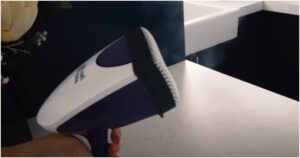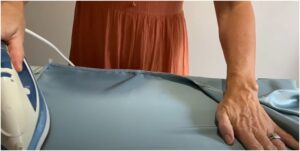
I’ll never forget the morning of my best friend’s wedding when her blush satin slip dress arrived from the tailor—beautifully altered, perfectly hemmed… and hopelessly wrinkled. The panic in her eyes was real.
She was about to reach for a hot iron when I practically dove across the room like a rom-com heroine to stop her. I knew that one wrong move could turn that glossy satin into a shiny, scorched disaster.
That’s when I stepped in with my know-how. Learning how to get wrinkles out of satin is a bit of an art form, but once you understand the fabric’s delicate nature and the right techniques, it becomes second nature. Satin’s charm is in its smooth, light-reflecting surface—and your goal is to keep that magic intact.
Why Is Satin So Tricky When It Comes to Wrinkles?

Satin isn’t a fiber—it’s a weave. That glossy face is created by floating yarns over each other in a way that catches the light, but it also means the fabric is prone to creases.
Heat, pressure, and moisture all affect it differently depending on whether it’s silk satin, polyester satin, or a blend.
That’s why a “one-size-fits-all” approach doesn’t work. The safest way to remove wrinkles depends on your satin type, and steaming is usually your best bet. But there are other methods for those “no steamer in sight” situations.
How to Get Wrinkles out of Satin: What Should You Do First?
Before you do anything, check the care label. It will tell you if your garment can handle steaming, low-heat ironing, or tumble drying (synthetic blends only). Satin is not forgiving when you ignore its rules.
Once you know your limits, set yourself up for success. Work in a clean, well-ventilated area, use distilled water if possible, and have a padded hanger ready. A little preparation makes all the difference in keeping satin pristine.
Can Steaming Really Save Satin? (Yes—Here’s How to Do It)
Steaming is my go-to for almost every satin piece in my collection, from vintage slip dresses to upcycled wedding gowns. It’s gentle, fast, and keeps that glossy surface safe.
Here’s my step-by-step process for steaming satin like a pro:
Step 1: Fill the steamer’s tank with clean water—distilled if possible to prevent mineral spots.

Image source- Alarna Hope
Step 2: Heat the steamer until it produces a steady stream of steam without spitting.

Step 3: Turn the garment inside out to protect the outer sheen.

Image Source- Pawda Baby
Step 4: Hang it on a padded hanger in a roomy space where you can move around.

Image source- LILYSILK
Step 5: Hold the nozzle 1–2 inches from the fabric and work in slow, downward strokes.

Step 6: Use your free hand to gently pull the fabric taut—this helps the steam smooth wrinkles faster.
Step 7: For stubborn creases, linger slightly longer (around 30 seconds) but keep the nozzle moving to avoid damp spots.

Step 8: Let the garment air dry for 15–20 minutes before wearing or storing.
If you don’t own a steamer, you can hang your satin in a bathroom while running a hot shower. It’s less precise, but it works in a pinch.
What If You Don’t Have a Steamer—Can You Iron Satin?
You can, but you need to tread carefully. Ironing satin without precautions is a recipe for shine marks or scorched spots. If you must iron satin:
Turn the garment inside out, set your iron to its lowest heat (synthetic or satin setting), and always use a clean, thin pressing cloth between the iron and the fabric.
Lightly press—never slide—the iron over the cloth. If needed, lightly mist the fabric first to help relax stubborn creases.
Once you’re done, hang the garment immediately so gravity can help set the smooth finish.
Are There Quick Fixes for Minor Satin Wrinkles?
Yes—and I’m all for having a few tricks up your sleeve. A wrinkle release spray can work wonders if you’re short on time.
Hang the garment, spray from 6–10 inches away, smooth gently with your hands, and let it air dry.
For some synthetic satin blends, the dryer method works too. Toss the garment in with a damp (not wet) towel, set the dryer to low heat, and run it for 5–10 minutes.
Remove it while still slightly damp and hang it right away. Never use this method for silk satin—it’s too delicate.
How Can You Prevent Satin Wrinkles in the First Place?
Prevention is always easier than repair. Store satin garments on padded hangers instead of folding them. If you must pack them, use tissue paper between folds. Avoid cramming them into a closet where they can get crushed.
And if you’re upcycling satin (one of my favorite sustainable fashion projects), give your fabric a gentle steam before cutting or sewing to ensure it’s perfectly smooth for precision work.
FAQ: How to Get Wrinkles out of Satin
Is steaming safe for all satin fabrics?
Mostly, yes. Polyester, silk, and blend satins all respond well to gentle steaming, but always check the care label first. If it says “dry clean only,” leave it to the professionals.
How long does it take to steam a satin dress?
Anywhere from 5 minutes for a simple slip to 15–20 minutes for a layered gown. Patience is key—moving too fast can leave wrinkles behind.
Can I use a hair dryer to get wrinkles out of satin?
Only as a last resort. A hair dryer can work in a pinch, but it doesn’t produce enough controlled steam, so results aren’t as smooth. Keep it at a low heat setting and at least 6 inches away.
What’s the biggest steaming mistake people make?
Holding the steamer too close or in one spot for too long. This can leave watermarks or even distort the weave. Keep the nozzle moving at all times.
Satin, Steamed, and Ready to Shine
Here’s my philosophy: satin is like a cat—it demands respect, a gentle touch, and a bit of patience, but when you treat it right, it rewards you with pure beauty.
Whether you’re smoothing out a thrifted treasure, prepping a gown for a big event, or keeping your everyday satin PJs looking luxe, knowing how to get wrinkles out of satin is a skill worth having.
And trust me, once you’ve mastered these methods, you’ll never panic at the sight of a creased satin dress again.
You’ll just grab your tools, work your magic, and let that fabric strut back into the spotlight—wrinkle-free and gorgeous.



